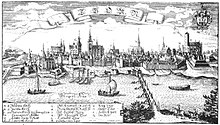Thorner Religious Discussion
The Thorner Religious Discussion (Latin Colloquium Charitativum Thoruniense ) took place from August 28, 1645 to November 21, 1645 in Thorn .
Occasion and purpose
King Wladislaus IV. Of Poland hoped to be able to clarify the complicated confessional conditions in his country and to restore church unity by means of a religious discussion. The difficult denominational starting position can be exemplified by the city of Thorn and its surrounding area. The predominantly Protestant city on the Vistula was close to the Protestant Duchy of Prussia , but belonged to the confessionally mixed Royal Prussia , which in 1569 had become part of the predominantly strict Catholic Polish-Lithuanian aristocratic republic of Rzeczpospolita through the Union of Lublin .
Participants and course
At the invitation of the King, the Thorner Religious Discussion began on August 28, 1645 in Thorn Town Hall, chaired by Grand Chancellor Georg Ossolinski . 26 Catholic , 28 Lutheran and 24 Reformed theologians were present. The participants included Orthodox Lutherans such as Johann Hülsemann (manager of the Lutheran department from Wittenberg), Abraham Calov and the Irish Georg Calixt (as adviser to the Königsberg Lutherans), as well as Unitarians such as Stanislaus Lubienietzki as representative of the Polish brothers .
Elector Friedrich Wilhelm von Brandenburg , in his function as Duke of Prussia and vassal of the Polish king, sent three Lutheran professors from the University of Königsberg to the religious discussion : Michael Behm , Christian Dreier and Levin Pouchern . The deliberations should take place in three phases: 1. Explain the beliefs of the denominations; 2. Review of these points of view for their correctness; 3. Clarification of the controversies. It soon became apparent, however, that the delegations were primarily interested in exposing the other side's viewpoints as heresy. Because of this attitude of those involved, the negotiations never got beyond the first phase and were broken off on November 21 after 36 meetings, four of which were public.
Consequences and Significance
As a result of the failure of the Thorner Religious Discussion, the political and religious tensions within Poland, especially within the city of Thorn, were not cleared. Decades later they discharged themselves in the Thorner tumult and Thorner blood court .
Nevertheless, the Thorner Religious Discussion is considered to be the most important attempt during the Thirty Years' War to bring about a balance between the denominations. Poland was not involved in the war that was raging in the Holy Roman Empire .
literature
- Hans-Joachim Müller: Irenik as a communication reform. The Colloquium Charitativum in Thorn 1645 . Vandenhoeck & Ruprecht, Göttingen 2004, ISBN 3-525-35860-1 ( publications of the Max Planck Institute for History 208).
- Inge Mager : Fraternity and Unity. Georg Calixt and the Thorner religious discussion 1645. In: Bernhart Jähnig (Hrsg.): Thorn. Queen of the Vistula. 1231-1981. Vandenhoeck & Ruprecht, Göttingen 1981, ISBN 3-525-85926-0 ( Contributions to the history of West Prussia 7), pp. 209-238.
- Franz Jacobi: The loving religious conversation at Thorn 1645. In: Zeitschrift für Kirchengeschichte 15, 1895, ISSN 0044-2925 , pp. 345–363, 485–560.
- Gerhard Müller, Horst Balz , Gerhard Krause (Hrsg.): Theologische Realenzyklopädie. Volume 7. De Gruyter, Berlin 1981, ISBN 3-11-002218-4 , p. 556 ( online ).
Footnotes
- ↑ Theodor Moldaenke: Art. Thorner colloquy . In: The religion in past and present , 1st edition, Vol. 5: Roh – Zypressen , Tübingen 1913, Sp. 1231–1232.
